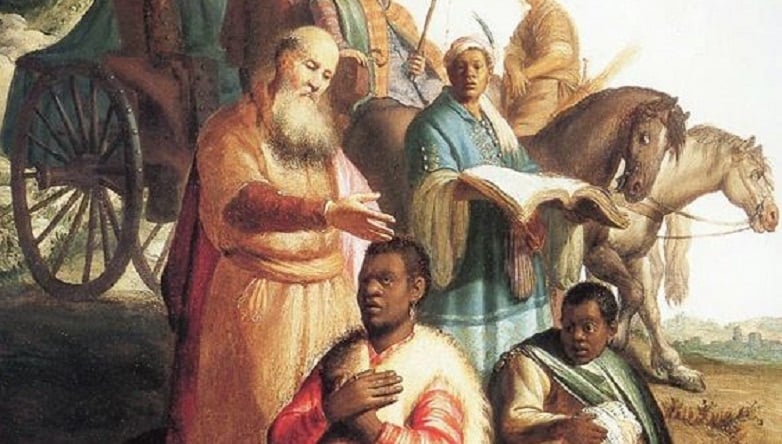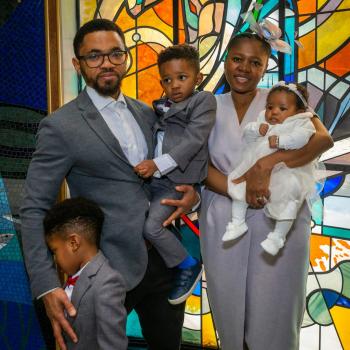The story of Philip and the Ethiopian Eunuch demonstrates how the Church should welcome and affirm transgender, intersex, and asexual folks.

Everybody loves the story of Philip and the Ethiopian Eunuch in Acts 8. I mean, it’s got so much to offer! When I was younger, the big takeaway was how the Holy Spirit teleported Philip from Samaria to Azotus (verses 39-40)! As a Baptist, I used this story as a proof text for believer’s baptism. Later, I noticed how the story involved Philip’s inclusion of someone from a different nation, language, race, and perhaps religion. Today I want to focus on Philip’s new friend as a member of the LGBTQIA+ community.
Who Was the Ethiopian Eunuch?
According to Kittredge Cherry’s article, “Ethiopian eunuch and Philip: Early church welcomed queers in Bible story,”
In the Bible the Ethiopian eunuch is nameless, but he goes by various names in different traditions. Second-century saint Irenaeus wrote about him as Simeon Bachos the Eunuch and said that he was sent to Ethiopia to preach. In African tradition his name is known as Qinaqis. Greek and Russian Orthodox calendars refer to him as Aetius. He is also named Djan Darada (Джан Дарада) in some Russian sources. In Eastern Orthodox tradition he is considered to be the same “Simeon the Black” or “Simeon who was called Niger” in Acts 13:1. The Ethiopian Orthodox Tewahedo tradition refers to him as Bachos.
For the purpose of this article, I’ll call him Simeon. Whether he is Simeon Niger or not is unclear—but I like the idea that this character comes up again in scripture. Luke says that he was “a court official of the Candace, the queen of the Ethiopians, in charge of her entire treasury. He had come to Jerusalem to worship and was returning home; seated in his chariot, he was reading the prophet Isaiah.”
What’s a Eunuch?
In Sunday school, the quick and dirty answer to a child’s question, “What’s a eunuch” is generally, “a royal official.” This isn’t wrong—it just isn’t complete. For some reason, the Church feels uncomfortable talking about genitals and gender diversity. This has done a great disservice to, well, everyone. The truth is, not all eunuchs were court officials, and not all court officials were physical eunuchs. But the two often went together. Eunuchs were people who could not reproduce. Some were born with intersex characteristics. Others (some voluntarily, some involuntarily) underwent surgery by cutting or crushing the testes. Still others simply took vows of celibacy, without surgically alterations.
In my last article, “When Did Jesus Mention Transgender, Intersex, and Asexual Folks?” I addressed Jesus’ mention of eunuchs, and how this applies to these three categories of Queer folks. I hope you’ll check it out.
Exclusion of Eunuchs
One of the noteworthy things about Simeon in Acts 8 was that he was coming from Jerusalem, but the story takes place in Samaria. The location is practically synonymous with exclusion and second-class citizenship. Reference to the region reminds the reader that if Simeon went up to the temple to worship, he certainly was excluded as “unclean.” Deuteronomy 23:1 expressly forbade eunuchs from the sacred assembly. Returning from Jerusalem, Simeon tried to find hope by reading the prophet Isaiah.
Simeon’s Baptism
In Luke’s narrative, Simeon Niger rides in his chariot, returning from Jerusalem after visiting Jerusalem. There, temple guards likely turned him away because of his gender identity. Philip the Evangelist comes alongside and asks what he’s reading. Simeon invites him into the vehicle to ride along and explain the text of Isaiah 53. Philip does so, revealing Jesus as the fulfillment of Isaiah’s prophecy. Simeon believes and says, “Look, here is water! What is to prevent me from being baptized?”
Acts never gives the reader a view into Philip’s internal dialogue. We don’t know how much time he took to decide what to do. He could have denied Simeon based on his race and ethnicity, gender identity or sexual orientation, nationality, language, or politics. Instead, he “commanded the chariot to stop, and both of them, Philip and the eunuch, went down into the water, and Philip baptized him.” In other words, there was nothing that prevented Philip from welcoming Simeon into full fellowship with Jesus, and with the Church.
They Shall Not Be Cut Off
The storyteller says that immediately afterward, the Holy Spirit whisked Philip away, leaving the eunuch to continue on his journey. Perhaps as he rode, he kept reading the book of Isaiah. Still in the glow of his baptism, Simeon’s mind would have been blown when he read Isaiah 56:3-5, which says:
Do not let the foreigner joined to the Lord say,
“The Lord will surely separate me from his people,”
and do not let the eunuch say,
“I am just a dry tree.”
For thus says the Lord:
To the eunuchs who keep my Sabbaths,
who choose the things that please me
and hold fast my covenant,
I will give, in my house and within my walls,
a monument and a name
better than sons and daughters;
I will give them an everlasting name
that shall not be cut off.
For someone who shunned from the sacred assembly because he had body parts removed, it must have come as a surprise to read that God had something special in store for him. What an amazing thing, to discover that in God’s eyes, he was welcome and accepted, even if the religious leaders at the temple didn’t acknowledge him! Whether he voluntarily or involuntarily cut parts off, or whether his asexuality caused him to be considered a eunuch, God considered him precious and loved. He knew that no matter what other people said, he would never be cut off from his Creator. The Church needs to learn this same thing today and include transgender, intersex, and asexual people like Simeon!
Queer Patron Saints
In her article, Kittredge Cherry suggests that “Philip could be considered a patron saint of LGBTQ allies.” Simeon Niger, by the same token, could be called a patron saint of transgender, intersex, and asexual people. The Church desperately needs patrons like this! We have spent too much time marginalizing LGBTQIA+ folks and driving them out of the Church like the temple leaders must have done to Simeon. Instead, we must welcome and affirm people of all genders and sexual orientations, without asking them to be something that they’re not. Along with Isaiah, we must “give them an everlasting name that shall not be cut off.”













